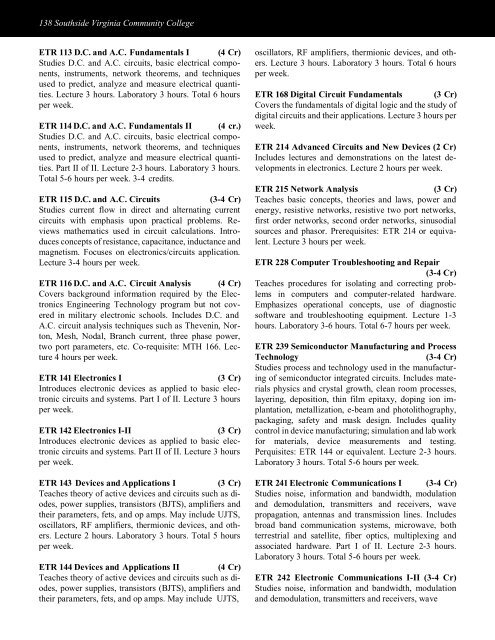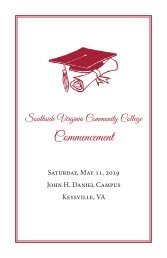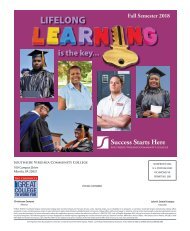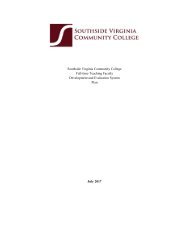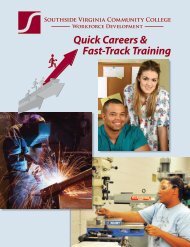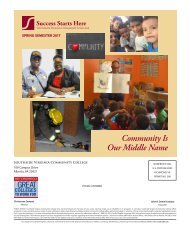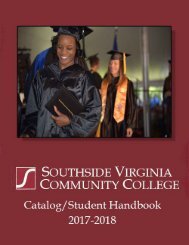SVCC Catalog/Handbook 2017-2018
Create successful ePaper yourself
Turn your PDF publications into a flip-book with our unique Google optimized e-Paper software.
138 Southside Virginia Community College<br />
ETR 113 D.C. and A.C. Fundamentals I (4 Cr)<br />
Studies D.C. and A.C. circuits, basic electrical components,<br />
instruments, network theorems, and techniques<br />
used to predict, analyze and measure electrical quantities.<br />
Lecture 3 hours. Laboratory 3 hours. Total 6 hours<br />
per week.<br />
ETR 114 D.C. and A.C. Fundamentals II (4 cr.)<br />
Studies D.C. and A.C. circuits, basic electrical components,<br />
instruments, network theorems, and techniques<br />
used to predict, analyze and measure electrical quantities.<br />
Part II of II. Lecture 2-3 hours. Laboratory 3 hours.<br />
Total 5-6 hours per week. 3-4 credits.<br />
ETR 115 D.C. and A.C. Circuits<br />
(3-4 Cr)<br />
Studies current flow in direct and alternating current<br />
circuits with emphasis upon practical problems. Reviews<br />
mathematics used in circuit calculations. Introduces<br />
concepts of resistance, capacitance, inductance and<br />
magnetism. Focuses on electronics/circuits application.<br />
Lecture 3-4 hours per week.<br />
ETR 116 D.C. and A.C. Circuit Analysis (4 Cr)<br />
Covers background information required by the Electronics<br />
Engineering Technology program but not covered<br />
in military electronic schools. Includes D.C. and<br />
A.C. circuit analysis techniques such as Thevenin, Norton,<br />
Mesh, Nodal, Branch current, three phase power,<br />
two port parameters, etc. Co-requisite: MTH 166. Lecture<br />
4 hours per week.<br />
ETR 141 Electronics I<br />
(3 Cr)<br />
Introduces electronic devices as applied to basic electronic<br />
circuits and systems. Part I of II. Lecture 3 hours<br />
per week.<br />
ETR 142 Electronics I-II<br />
(3 Cr)<br />
Introduces electronic devices as applied to basic electronic<br />
circuits and systems. Part II of II. Lecture 3 hours<br />
per week.<br />
ETR 143 Devices and Applications I (3 Cr)<br />
Teaches theory of active devices and circuits such as diodes,<br />
power supplies, transistors (BJTS), amplifiers and<br />
their parameters, fets, and op amps. May include UJTS,<br />
oscillators, RF amplifiers, thermionic devices, and others.<br />
Lecture 2 hours. Laboratory 3 hours. Total 5 hours<br />
per week.<br />
ETR 144 Devices and Applications II (4 Cr)<br />
Teaches theory of active devices and circuits such as diodes,<br />
power supplies, transistors (BJTS), amplifiers and<br />
their parameters, fets, and op amps. May include UJTS,<br />
oscillators, RF amplifiers, thermionic devices, and others.<br />
Lecture 3 hours. Laboratory 3 hours. Total 6 hours<br />
per week.<br />
ETR 168 Digital Circuit Fundamentals (3 Cr)<br />
Covers the fundamentals of digital logic and the study of<br />
digital circuits and their applications. Lecture 3 hours per<br />
week.<br />
ETR 214 Advanced Circuits and New Devices (2 Cr)<br />
Includes lectures and demonstrations on the latest developments<br />
in electronics. Lecture 2 hours per week.<br />
ETR 215 Network Analysis<br />
(3 Cr)<br />
Teaches basic concepts, theories and laws, power and<br />
energy, resistive networks, resistive two port networks,<br />
first order networks, second order networks, sinusodial<br />
sources and phasor. Prerequisites: ETR 214 or equivalent.<br />
Lecture 3 hours per week.<br />
ETR 228 Computer Troubleshooting and Repair<br />
(3-4 Cr)<br />
Teaches procedures for isolating and correcting problems<br />
in computers and computer-related hardware.<br />
Emphasizes operational concepts, use of diagnostic<br />
software and troubleshooting equipment. Lecture 1-3<br />
hours. Laboratory 3-6 hours. Total 6-7 hours per week.<br />
ETR 239 Semiconductor Manufacturing and Process<br />
Technology<br />
(3-4 Cr)<br />
Studies process and technology used in the manufacturing<br />
of semiconductor integrated circuits. Includes materials<br />
physics and crystal growth, clean room processes,<br />
layering, deposition, thin film epitaxy, doping ion implantation,<br />
metallization, e-beam and photolithography,<br />
packaging, safety and mask design. Includes quality<br />
control in device manufacturing; simulation and lab work<br />
for materials, device measurements and testing.<br />
Perquisites: ETR 144 or equivalent. Lecture 2-3 hours.<br />
Laboratory 3 hours. Total 5-6 hours per week.<br />
ETR 241 Electronic Communications I (3-4 Cr)<br />
Studies noise, information and bandwidth, modulation<br />
and demodulation, transmitters and receivers, wave<br />
propagation, antennas and transmission lines. Includes<br />
broad band communication systems, microwave, both<br />
terrestrial and satellite, fiber optics, multiplexing and<br />
associated hardware. Part I of II. Lecture 2-3 hours.<br />
Laboratory 3 hours. Total 5-6 hours per week.<br />
ETR 242 Electronic Communications I-II (3-4 Cr)<br />
Studies noise, information and bandwidth, modulation<br />
and demodulation, transmitters and receivers, wave


